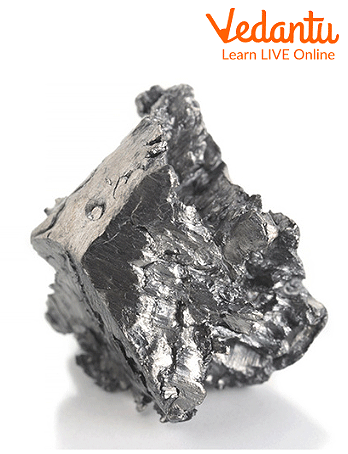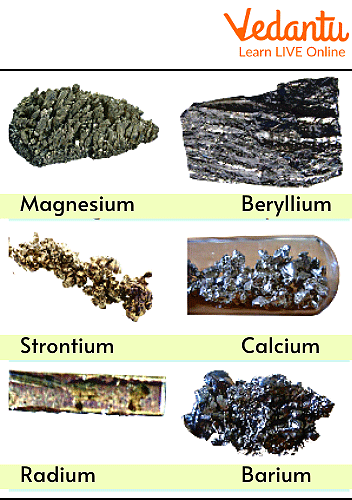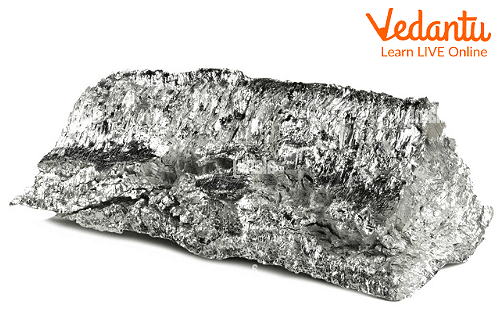




What are Alkaline Earth Metals
The family of chemical elements called alkaline earth metals includes beryllium, magnesium, calcium, strontium, barium and radium. These chemical elements occupy the second column of the periodic table. The designation of the earth for these elements came from the Middle Ages when chemists referred to several substances that were insoluble in water and unchanged by fire, such as earth.
Alkaline earth metals are lustrous, soft or semi-soft metals insoluble in water. They are generally harder and less reactive than metals in group IA, such as sodium, and are softer and more reactive than metals in group IIIA, such as aluminium. When they combine with oxides (molecules of oxygen and another element), they form some of the most common minerals on Earth, with various uses in industry, medicine, and consumer goods. Some compounds give off a lot of light when heated, making them a key element in fireworks.

Alkaline Earth Metal
Properties of Alkaline Earth Metals
The presence of alkaline earth metals is silvery white.
These are soft metals.
Their boiling point is higher than that of alkali metals.
These elements can be tested by flame test as they give different colours when exposed to flame.
These metals can conduct electricity.
Alkaline earth metals have high electronegativity so they are electropositive.
Magnesium is an alkaline earth metal that does not give any colours when exposed to flame.
Alkaline earth metals are good conductors of heat.

Types of Alkaline Earth Metals
How are Alkaline Earth Metals Used?
Uses of Alkaline Earth Metals in daily life. Some of these uses are given below:
Magnesium is used to make a variety of alloys.
Magnesium is also used in medicines to take antacids.

Magnesium Alkaline Earth Metal
Radium is used to treat cancer.
Calcium is used in the extraction of various elements.
Calcium is used to produce calcium carbonate, which is used in various products such as marble, chalk, limestone, etc.
Plaster of Paris is also made from calcium and is used in decoration, designing and fireproofing.
3 Useful Applications of Alkaline Earth Metals
Hydrogen gas is used for many purposes. Hydrogen gas is obtained from the reaction of alkaline earth metals with acids.
Alkaline earth metals are used in making electrochemical and photoelectric cells.
Alloys of magnesium are used to manufacture aircraft and fighter aircraft.
Solved Questions
Which alkali earth metal is used to treat cancer?
Ans: Radium is used to treat cancer.
Write two properties of alkali earth metals.
Ans: Two uses of alkali earth metals are:
They have a high boiling point.
They can conduct electricity.
Write two uses of alkali earth metals.
Ans: Two uses of alkali earth metals are:
Calcium is used to make calcium carbonate which is used to make various products like chalk, marble, limestone etc.
Alloys of magnesium are used in the manufacture of aircraft and fighter aircraft.
Learning by Doing
Write True or False.
Calcium is not an Alkali Earth metal.
Radium is an Alkali Earth metal.
Alkaline earth metals are bad conductors of heat.
Alkali Earth metals are soft metals.
Summary
This chapter helped us to understand the basics of Alkali Earth Metals. We have studied many things about it, like its properties and uses, which will help us to gain some practical knowledge and understanding. It is a very important topic in Chemistry. This helps us to know the chemical elements of alkali earth metals.
FAQs on Uses of Alkaline Earth Metals
1. Which elements are known as alkaline earth metals?
The alkaline earth metals are the six chemical elements in Group 2 of the periodic table. They are Beryllium (Be), Magnesium (Mg), Calcium (Ca), Strontium (Sr), Barium (Ba), and Radium (Ra). These elements are known for being reactive and having two valence electrons.
2. Why are Group 2 elements called 'alkaline earth metals'?
These elements earned their name for two main reasons. They are called 'alkaline' because their oxides and hydroxides are alkaline (basic) in nature. The term 'earth' was historically used by alchemists to describe non-metallic substances that were insoluble in water and stable to heating, which described the properties of their oxides.
3. What are some important industrial uses of alkaline earth metals and their compounds?
Alkaline earth metals and their compounds have diverse industrial applications.
- Magnesium (Mg) is used to create strong, lightweight alloys with aluminium, which are used in aircraft and car manufacturing.
- Beryllium (Be) is used to make alloys with copper for manufacturing high-strength springs and in X-ray tubes.
- Calcium (Ca) compounds are essential in producing cement and mortar for construction.
- Barium sulphate (BaSO₄) is used in drilling fluids for oil and gas wells and as a filler in paints and plastics.
4. What is the biological importance of magnesium and calcium in the human body?
Magnesium and calcium are vital for biological functions.
- Calcium (Ca²⁺) is a primary component of bones and teeth. It also plays a crucial role in muscle contraction, nerve impulse transmission, and blood clotting.
- Magnesium (Mg²⁺) is essential for the activity of many enzymes and is found in chlorophyll, the pigment that facilitates photosynthesis in plants. In humans, it supports muscle and nerve function, energy production, and helps regulate blood pressure.
5. How are alkaline earth metals used to create colours in fireworks?
Alkaline earth metals are used in pyrotechnics because they impart vibrant, distinct colours when heated in a flame. This happens because their electrons absorb energy and jump to higher energy levels, then release this energy as visible light upon returning to their ground state.
- Strontium (Sr) compounds produce a brilliant crimson red.
- Calcium (Ca) compounds produce an orange-red or brick-red colour.
- Barium (Ba) compounds produce an apple-green colour.
- Magnesium (Mg) burns with a very bright white light, often used for sparkles.
6. Why does beryllium have different uses compared to other alkaline earth metals?
Beryllium's uses differ due to its anomalous properties, which stem from its very small atomic size and high ionisation enthalpy. Unlike other Group 2 metals, it is extremely hard, has a high melting point, and is an excellent conductor of heat. Its unique ability to be transparent to X-rays makes it invaluable for the 'windows' in X-ray tubes and particle detectors, a use not shared by other alkaline earth metals.
7. What is the role of calcium compounds in construction and building materials?
Calcium compounds are fundamental to the construction industry.
- Calcium Carbonate (CaCO₃), in the form of limestone and marble, is used as a building material and in the manufacturing of cement.
- Calcium Oxide (CaO), or quicklime, is a key ingredient in cement and is used to treat soil.
- Calcium Sulphate (CaSO₄·2H₂O), or gypsum, is used to make Plaster of Paris (CaSO₄·½H₂O), which is widely used for creating casts, moulds, and finishing walls.
8. Why is radium, an alkaline earth metal, highly toxic and not used biologically?
Radium has no biological use and is highly toxic because it is intensely radioactive. The body can mistake radium for calcium due to their chemical similarity and deposit it in bones. The radiation emitted by radium can then damage surrounding tissues, leading to bone cancer and other serious health issues. Its only significant medical application was in early radiotherapy for cancer, which has now been replaced by safer alternatives.
9. How is magnesium used in medicine?
Magnesium compounds have several medical applications. Magnesium hydroxide (Mg(OH)₂), also known as milk of magnesia, is commonly used as an antacid to neutralise stomach acid and as a laxative. Magnesium sulphate (Epsom salt) is used to treat magnesium deficiency, reduce inflammation, and can be administered intravenously to prevent seizures in certain conditions like eclampsia.
10. What is a common household use of calcium carbonate?
A very common household use of calcium carbonate (CaCO₃) is as a mild abrasive in toothpaste. Its gentle scrubbing action helps to remove plaque and surface stains from teeth without damaging the enamel. It is also used as a dietary calcium supplement and as the active ingredient in many over-the-counter antacid tablets to relieve heartburn and indigestion.









